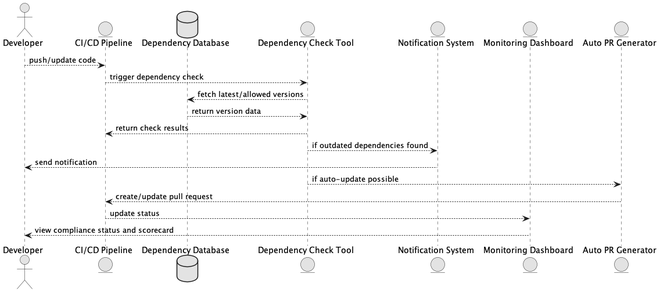Dependency Hygiene for Organizations

Table of Contents
Background #
Regularly updating dependencies is a widely recognized best practice in software engineering, advocated by numerous industry leaders and experts. The motivation behind keeping dependencies up-to-date organization-wide is to ensure compatibility, leverage new features, and maintain security standards.
Keeping dependencies up to date is closely linked to managing technical debt in software development for several reasons. Technical debt refers to the implied cost of additional rework caused by choosing an easy solution now instead of using a better approach that would take longer. Here’s why keeping dependencies updated is a crucial part of managing this debt:
Security Vulnerabilities: One of the most critical reasons to update dependencies is to patch security vulnerabilities. Older versions of libraries may contain security flaws that are often exploited. By not updating, you expose your software to potential security breaches, which can be costly in terms of both direct impact and reputational damage.
Bug Fixes: Dependencies are updated not just for new features but also for bug fixes. Using older versions can mean your software is plagued with known bugs that have already been resolved in newer versions. This can lead to a poorer user experience and more time spent on support and bug-fixing than necessary, diverting resources from new feature development.
New Features and Improvements: New versions of dependencies often come with improvements in performance and new features that can make your software more efficient and capable. By not updating, you miss out on these enhancements, potentially putting your product at a competitive disadvantage.
Compatibility Issues: Software ecosystems evolve, and new releases of frameworks and tools can sometimes break compatibility with older versions of dependencies. Delaying updates can lead to a situation where you need to update several dependencies at once, which can be more difficult and risky compared to incremental updates. This “update lag” can make integrating and testing much harder due to compounded changes.
Maintainability and Developer Morale: Working with outdated tools and libraries can be frustrating for developers, especially if they’re familiar with the benefits of newer versions. Moreover, the knowledge around older versions diminishes over time as the community and support shift focus to newer versions, making maintenance more challenging and isolating for developers.
Market Perception and Customer Trust: Using outdated technologies can affect how customers perceive your product. It might signal that the product is not being actively improved or kept secure, which can erode trust, especially for B2B software solutions where security and reliability are paramount.
Long-Term Cost: While updating dependencies regularly requires an upfront investment in time and resources, it often results in lower costs in the long run. It prevents the accumulation of changes that need to be managed all at once, which can be disruptive and expensive, requiring significant rework and testing.
Following strategy will help in preventing the technical debt associated with outdated dependencies, especially in large-scale environments where multiple teams might be working in silos.
Requirements #
To get started, here are some high-level requirements to consider:
Must Have: Automated checks to ensure dependency versions in project descriptors like
package.json,pom.xml, gradle lib catalogs and project descriptors, are not more than six months out-of-date.Should Have: Notification systems to alert project maintainers when dependencies are nearing or have exceeded the six-months threshold.
Could Have: Integration of these checks into a continuous integration pipeline to prevent merging outdated dependencies.
Won’t Have Initially: Manual processes for updating dependencies; aim for automation.
Proactive Enforcement #
To enforce the dependency update policy, we can utilize a combination of tools to monitor and upgrade dependencies automatically and integration into CI/CD pipelines.

Mandatory Update Windows #
Implement a policy where dependencies must be reviewed and, if necessary, updated at least every quarter. This ensures that updates are manageable and spread throughout the year rather than becoming a large annual task.
Dependency Freeze #
Establish a dependency freeze – period during which no new features can be added until the outdated dependencies are updated. This practice puts a clear priority on maintenance tasks over new development when necessary.
Automated Pull Requests #
Use tools like dependabot, renovate and snyk, that automatically create pull requests with updated dependencies. This reduces the manual work required by the team and makes updates easier to review and merge.
Incentive Mechanisms #
Compliance Scorecard #
Develop a compliance scorecard that rates projects based on how up-to-date their dependencies are. Projects meeting the criteria could be eligible for rewards such as recognition in company meetings, more autonomy in project decisions, or other incentives that promote a proactive culture.
Rising Awareness; Training and Resources #
Provide training sessions, workshops, and resources about the importance of dependency management and the risks associated with outdated dependencies. Educating teams on the potential security vulnerabilities and compatibility issues can motivate them to keep their projects updated.
Gamification #
Introduce elements of gamification, such as leaderboards and badges, to recognize and reward teams that keep their dependencies up-to-date. Recognizing teams during company meetings or through internal newsletters can also provide additional motivation. This can foster a competitive spirit and encourage compliance.
Facilitate Easy Updates #
Make it as easy as possible for teams to update their dependencies. This could include:
- Automated tools that can suggest or even apply updates automatically for minor and patch-level updates.
- Regular internal audits where a dedicated team assists in updating complex dependencies.
Feedback Loop #
Establish a feedback loop where teams can report back on the challenges and successes they encounter while updating dependencies. This feedback can help in refining the processes and policies over time, making it easier and more efficient for everyone to stay updated.
Leadership Example #
Encourage senior developers and team leaders to set examples by prioritizing dependency updates in their projects. Leadership buy-in is crucial in shaping the culture around dependency management.
Implementation #
Phase 1: Policy and Tools Setup — Develop and communicate the policies, and integrate the required tools into your development pipeline.
Phase 2: Education and Encouragement Initiatives — Roll out training sessions and start the gamification process.
Phase 3: Monitoring and Feedback — Implement the monitoring dashboard and start the feedback loop to continuously improve the process.
Implementation Considerations #
- Tool Development: The dependency check tool should now also handle the generation of automated pull requests and interact with the compliance scorecard.
- Dashboard Enhancements: The monitoring dashboard needs to be enhanced to include compliance scores and possibly integrate gamification elements.
Conclusion #
This approach combines strict enforcement mechanisms with positive encouragement techniques, creating a balanced environment where teams understand the importance of keeping their dependencies up to date and feel motivated to do so.
This is a critical aspect of modern software development: keeping dependencies updated is essential not just for taking advantage of new features, but also for ensuring the security and efficiency of software applications. By staying current, teams can avoid the pitfalls of security vulnerabilities, deprecated features, and compatibility issues that often arise with older dependencies.